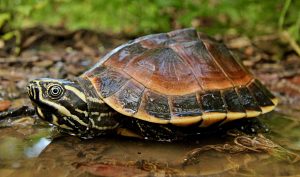Malayemys subtrijuga, 111
Malayemys subtrijuga (Schlegel and Müller 1845) –
Mekong Snail-Eating Turtle
Jeffrey E. Dawson1, Flora Ihlow1, and Steven G. Platt2
1Museum of Zoology, Senckenberg Dresden, Königsbrücker Landstrasse 159, 01109 Dresden, Germany
[[email protected]; [email protected]];
2Wildlife Conservation Society and Turtle Survival Alliance – Myanmar Program,
No. 12, Nanrattaw St., Kamayut Township, Yangon, Myanmar [[email protected]]
Summary. – The Mekong Snail-eating Turtle, Malayemys subtrijuga (family Geoemydidae), is a small (carapace length typically under 200 mm, but reaching up to 236 mm) freshwater turtle inhabiting wetlands, rice fields, and other seasonal lowland habitats in Southeast Asia. The species has an unusual distribution: a disjunct population on the island of Java in Indonesia, which could be either a centuries-old anthropogenic introduction or a naturally occurring relict, and an extensive occurrence across the lower Mekong River drainage of the southeastern Indochinese Peninsula. The species exhibits sexual dimorphism in body size, with females growing considerably larger than males. Individuals have enlarged heads and other specializations for a diet consisting largely of molluscs. Clutches of up to 10 eggs are laid during the dry season (December–March in Cambodia), and incubation is timed so that hatchlings emerge at the beginning of the wet season. Many aspects of the species’ natural history remain poorly known. Although considerable habitat is available, populations throughout the species’ distributional range appear to have declined as a result of exploitation. Reduction in the level of collection and additional research and management are needed for the conservation of this species.
Distribution. – Cambodia, Indonesia, Laos, and Vietnam. An isolated population is present on the Indonesian island of Java. The species occurs in lowland areas throughout Cambodia, southern Laos, and southern Vietnam.
Synonymy. – Emys subtrijuga Schlegel and Müller 1845, Damonia subtrijuga, Geoclemys subtrijuga, Cistudo gibbosa Bleeker 1857 (nomen nudum), Emys nuchalis Blyth 1863, Bellia nuchalis, Damonia crassiceps Gray 1870, Damonia oblonga Gray 1871.
Subspecies. – None currently recognized.
Status. – IUCN 2020 Red List: Vulnerable (VU A1d+2d, assessed 2000); TFTSG Draft Red List: Near Threatened (NT, assessed 2018); CITES: Appendix II.
Citation:
Dawson, J.E., Ihlow, F., and Platt, S.G. 2020. Malayemys subtrijuga (Schlegel and Müller 1845) – Mekong Snail-Eating Turtle. In: Rhodin, A.G.J., Iverson, J.B., van Dijk, P.P., Stanford, C.B., Goode, E.V., Buhlmann, K.A., and Mittermeier, R.A. (Eds.). Conservation Biology of Freshwater Turtles and Tortoises: A Compilation Project of the IUCN/SSC Tortoise and Freshwater Turtle Specialist Group. Chelonian Research Monographs 5(14):111.1–24. doi: 10.3854/crm.5.111.subtrijuga.v1.2020; www.iucn-tftsg.org/cbftt/.
Download pdf
Adobe Acrobat 6.0 or later required)
Adult Malayemys subtrijuga from Tonle Sap Lake Biosphere Reserve, Battambang Province, Cambodia.
Photo by Flora Ihlow.
.
Distribution:
Distribution of Malayemys subtrijuga in left: Southeast Asia (Laos, Cambodia, Vietnam, and Java, Indonesia) and right: detailed view of Indochinese Peninsula (Laos, Cambodia, and Vietnam). Yellow dots = museum and literature occurrence records of native populations based on Iverson (1992) plus more recent and authors’ data; orange dots = uncertain native, introduced, misidentified, or trade specimens; red shading = presumed native historic indigenous range; gray shading = possibly historically introduced populations. Distribution based on GIS-defined level 12 HUCs (hydrologic unit compartments) constructed around verified localities and then adding HUCs that connect known point localities in the same watershed or physiographic region, and similar habitats and elevations as verified HUCs (Buhlmann et al. 2009; TTWG 2017, in press), and adjusted based on authors’ subsequent data.











